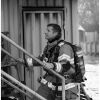In our dynamic fire environment, strategic decision-making can mean the difference between a successful operation or a tragic loss. Among the most critical decisions an incident commander must make is whether to initiate an offensive fire attack or defensive fire attack strategy. While both approaches aim to extinguish fire and protect life and property, their application, execution and implications vary significantly. Understanding the distinction between these strategies and when to transition from one to the other is essential to effective fireground leadership.
What is offensive fire attack?
An offensive fire attack refers to an aggressive, interior assault on the fire from within a structure. This strategy is employed when conditions permit firefighters to enter a building and directly engage the seat of the fire. The offensive fire attack approach aligns with the overarching principle of confining the fire to its room of origin or, at the very least, to the structure involved to minimize property damage and prevent spread to adjacent exposures.
Interior fire attack operations are inherently high-risk, typically conducted in an Immediately Dangerous to Life or Health (IDLH) environment. Fire companies are deployed inside the building with the aim of quickly locating and extinguishing the fire while simultaneously conducting search and rescue operations. Offensive fire operations require coordination, adequate staffing, and supporting tactics such as ventilation, water supply and rapid intervention teams.
The offensive strategy is centered on the principle of urgently hitting the fire early to regain control of the structure and maximize life safety outcomes. However, it demands a risk assessment – structural integrity, fire conditions and resource availability all factor into the decision to initiate an offensive tactic.
What is defensive fire attack?
In contrast, a defensive fire attack is adopted when the risks of interior engagement outweigh the benefits or are currently unachievable. This strategy involves conducting fire suppression from the exterior of the structure. The primary goal shifts from interior fire control to exposure protection, fire containment and preventing further loss due to fire spread.
Typically, the defensive fire attack mode is employed when a structure is potentially lost or unsafe for entry due to collapse risks, high fire load, or untenable interior conditions. A defensive posture does not equate to inaction or retreat; rather, it reflects a strategic reassessment based on evolving fireground intelligence. Master streams, large-diameter hoselines and elevated aerial devices are typically utilized during of a defensive fire attack, designed to apply large volumes of water from a distance.
When to switch from offensive to defensive fire attack?
Switching from offensive to defensive should occur when conditions inside the structure become too dangerous or when the risk to firefighter safety outweighs the benefits of continuing an interior attack. This transition is a critical decision that reflects a shift from life-saving interior efforts to an emphasis on containment and exposure protection from a safer exterior position.
Key indicators for the switch from offensive to defensive fire attack include:
- Signs of structural collapse (e.g., bowing walls, sagging roof)
- Rapid fire progression that outpaces suppression efforts
- Deteriorating visibility and high interior heat conditions
- Loss of water supply or inadequate staffing to maintain a safe operation
Example 1: If crews operating inside report that the floor is becoming spongy or unstable, indicating potential collapse, the IC may order an immediate withdrawal and initiate a defensive operation from the exterior.
Example 2: During an interior attack, if fire extends into concealed spaces and rapidly spreads to the attic, making fire control difficult and trapping heat above firefighters, it may be necessary to transition to a defensive posture to protect exposures or access the concealed spaces.
When to switch from defensive to offensive fire attack?
Switching from defensive to offensive may occur when conditions on the fireground improve to the point where a safe, coordinated interior attack is once again feasible. This shift indicates that suppression from the exterior has reduced the fire’s intensity and that re-entry can help with final extinguishment or search and rescue efforts.
Key indicators for the transition from defensive to offensive fire attack include:
- Fire has been knocked down to a controllable level
- Structural integrity has been reassessed and deemed safe for entry
- Adequate personnel and equipment are on scene to support the offensive operation
- Improved interior visibility and manageable heat levels
- Clear communication and coordination are established among responding units
Example 1: After using aerial master streams or large diameter handlines to control a large portion of the fire from the outside, an IC might determine that crews can safely re-enter the structure to perform a targeted interior attack and complete extinguishment or conduct search and rescue.
Example 2: In a commercial fire where initial conditions warranted a defensive operation, a reassessment after exterior suppression shows the fire is contained to one wing of the structure. Due to the remaining areas having stabilized, a transition to offensive mode may be decided to perform salvage and overhaul operations.
Maintain your mindset
A common misconception is that a defensive operation is associated with failure or quitting on the incident. On the contrary, it is a deliberate, proactive strategy aimed at preserving life and property with firefighter safety as the foremost concern. The firefighters operating in a defensive capacity must still seek the most advantageous tactical positions, not merely the safest distance. True professionalism in the fire service means adapting when assessing situations and executing strategies with purpose, whether interior or exterior. At its core, the difference between offensive and defensive fire attack strategies reflects a balance between aggressive action and calculated restraint. Incident commanders and their companies must be equally versed in both tactics, ready to pivot based on conditions.
This article, originally published May 29, 2025, has been updated with a video.







